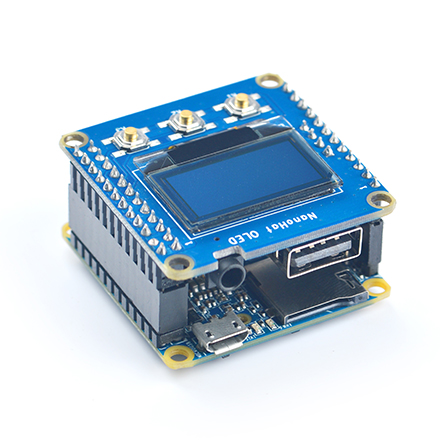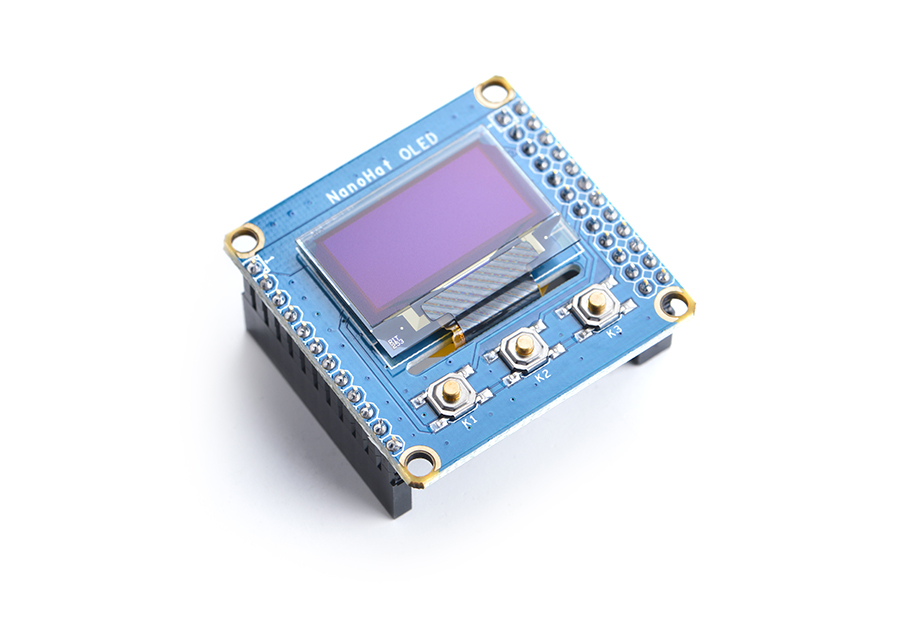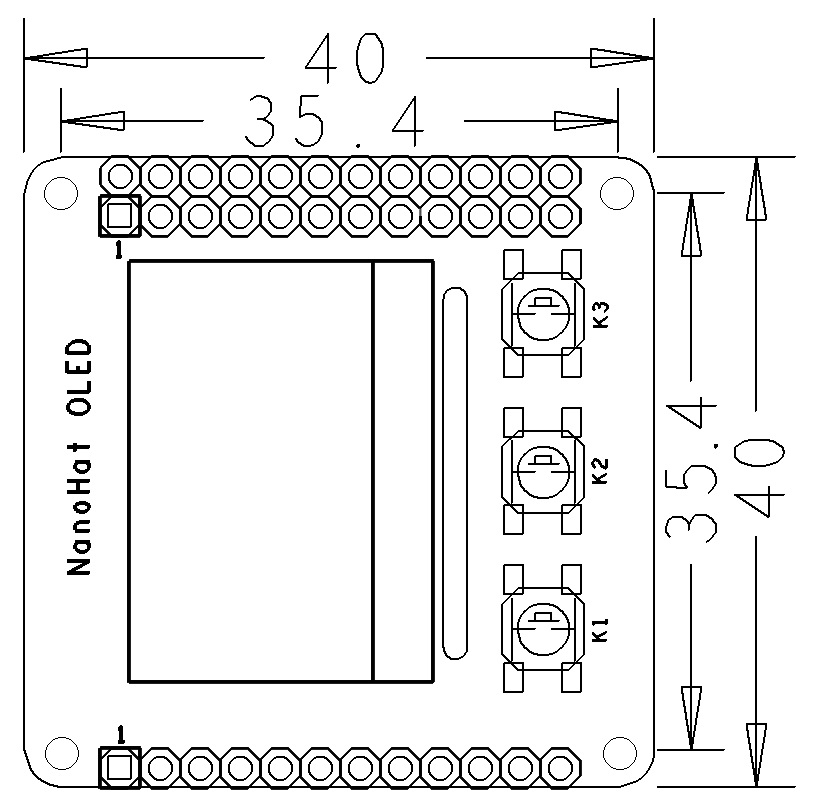Difference between revisions of "NanoHat OLED"
(→Hardware Setup) |
|||
| Line 51: | Line 51: | ||
Here is a hardware setup:<br> | Here is a hardware setup:<br> | ||
[[File:NanoHat OLED_nanopi_NEO.jpg|frameless|600px|NanoHat OLED_nanopi_NEO]]<br> | [[File:NanoHat OLED_nanopi_NEO.jpg|frameless|600px|NanoHat OLED_nanopi_NEO]]<br> | ||
| − | Applicable Boards<br /> | + | Applicable Boards:<br /> |
NanoPi NEO<br /> | NanoPi NEO<br /> | ||
NanoPi NEO Air<br /> | NanoPi NEO Air<br /> | ||
NanoPi NEO2<br /> | NanoPi NEO2<br /> | ||
| − | == | + | ==Install Software== |
| − | NanoHat | + | There are some code samples for NanoHat OLED. You can get these samples by running the following commands under Ubuntu core:<br /> |
<syntaxhighlight lang="bash"> | <syntaxhighlight lang="bash"> | ||
git clone https://github.com/friendlyarm/NanoHatOLED.git | git clone https://github.com/friendlyarm/NanoHatOLED.git | ||
| Line 64: | Line 64: | ||
</syntaxhighlight> | </syntaxhighlight> | ||
<br /> | <br /> | ||
| − | + | The script downloads and installs the samples and some utilities. Mainland Chinese users can download them faster by changing the source:<br /> | |
| − | + | Open the "/etc/apt/sources.list" file, copy the following lines to replace the existing contents:<br /> | |
<syntaxhighlight lang="bash"> | <syntaxhighlight lang="bash"> | ||
deb http://mirrors.ustc.edu.cn/ubuntu-ports/ xenial main multiverse restricted universe | deb http://mirrors.ustc.edu.cn/ubuntu-ports/ xenial main multiverse restricted universe | ||
| Line 78: | Line 78: | ||
deb-src http://mirrors.ustc.edu.cn/ubuntu-ports/ xenial-updates main multiverse restricted universe | deb-src http://mirrors.ustc.edu.cn/ubuntu-ports/ xenial-updates main multiverse restricted universe | ||
</syntaxhighlight> | </syntaxhighlight> | ||
| − | + | Or edit(or create) the "$HOME/.pip/pip.conf" file and set Python's pip to a mainland Chinese source. Here is what pip.conf looks like: | |
<syntaxhighlight lang="bash"> | <syntaxhighlight lang="bash"> | ||
[global] | [global] | ||
| Line 84: | Line 84: | ||
index-url = http://mirrors.aliyun.com/pypi/simple | index-url = http://mirrors.aliyun.com/pypi/simple | ||
</syntaxhighlight> | </syntaxhighlight> | ||
| − | + | After these commands are executed run "sudo apt-get update" to update software packages and then run "./install.sh" to begin installation. | |
<br /> | <br /> | ||
Revision as of 02:27, 27 April 2017
1 Introduction
- NanoHat OLED is a small and cute monochrome OLED module with low power consumption. It is 0.96". Its resolution is 128 x 64. It communicates with a master device with I2C.
- The NanoHat OLED module has the same form factor as FriendlyElec's NanoPi NEO. It can be stacked on a NanoPi NEO.
- It has three onboard programmable user buttons, a 2.0mm pitch 4-Pin I2C connector.
2 Hardware Spec
- Display Area:0.96"
- Resolution: 128 x 64
- High Contrast, Low Power Consumption
- 3 x Onboard Button
- PCB Dimension(mm): 40 x 40
- GPIO Pin Description
Pin# Name Linux gpio Pin# Name Linux gpio 1 SYS_3.3V 2 VDD_5V 3 I2C0_SDA 4 VDD_5V 5 I2C0_SCL 6 GND 7 NC 8 NC 9 GND 10 NC 11 K1 0 12 NC 13 K2 2 14 GND 15 K3 3 16 NC 17 SYS_3.3V 18 NC 19 NC 20 GND 21 NC 22 NC 23 NC 24 NC
Only GND and 5V on the 12-Pin land are connected and the rest pins are open. For more details on the 12-Pin connector refer to NanoPi NEO/Air/NEO2's wiki site.
3 Hardware Setup
Currently only the NanoPi NEO, NEO2 and NanoPi NEO Air work with this module.
The NanoHat OLED module has the same form factor as FriendlyElec's NanoPi NEO. It can be stacked on a NanoPi NEO/NEO2/Air.
Here is a hardware setup:

Applicable Boards:
NanoPi NEO
NanoPi NEO Air
NanoPi NEO2
4 Install Software
There are some code samples for NanoHat OLED. You can get these samples by running the following commands under Ubuntu core:
git clone https://github.com/friendlyarm/NanoHatOLED.git cd NanoHatOLED sudo -H ./install.sh
The script downloads and installs the samples and some utilities. Mainland Chinese users can download them faster by changing the source:
Open the "/etc/apt/sources.list" file, copy the following lines to replace the existing contents:
deb http://mirrors.ustc.edu.cn/ubuntu-ports/ xenial main multiverse restricted universe deb http://mirrors.ustc.edu.cn/ubuntu-ports/ xenial-backports main multiverse restricted universe deb http://mirrors.ustc.edu.cn/ubuntu-ports/ xenial-proposed main multiverse restricted universe deb http://mirrors.ustc.edu.cn/ubuntu-ports/ xenial-security main multiverse restricted universe deb http://mirrors.ustc.edu.cn/ubuntu-ports/ xenial-updates main multiverse restricted universe deb-src http://mirrors.ustc.edu.cn/ubuntu-ports/ xenial main multiverse restricted universe deb-src http://mirrors.ustc.edu.cn/ubuntu-ports/ xenial-backports main multiverse restricted universe deb-src http://mirrors.ustc.edu.cn/ubuntu-ports/ xenial-proposed main multiverse restricted universe deb-src http://mirrors.ustc.edu.cn/ubuntu-ports/ xenial-security main multiverse restricted universe deb-src http://mirrors.ustc.edu.cn/ubuntu-ports/ xenial-updates main multiverse restricted universe
Or edit(or create) the "$HOME/.pip/pip.conf" file and set Python's pip to a mainland Chinese source. Here is what pip.conf looks like:
[global] trusted-host = mirrors.aliyun.com index-url = http://mirrors.aliyun.com/pypi/simple
After these commands are executed run "sudo apt-get update" to update software packages and then run "./install.sh" to begin installation.
5 演示程序的操作说明
演示程序在安装后会在开机时自动运行,并默认显示 日期与时间 画面。
NanoHat OLED配件上的三个按键功能如下:
K1 -> 显示日期时间;
K2 -> 显示开发板的运行状态,例如 IP地址, 负载, 存储状态,CPU温度等信息;
K3 -> 关机操作,并不会立即关机,而是先弹出询问画面,在询问画面的状态下,用 K1 切换 Yes和No选项,K2进行确认;

